ON THE TABLE - AUGUST 21, 2013
 Monday, August 19, 2013 at 05:46PM
Monday, August 19, 2013 at 05:46PM
 (Audi)
(Audi)
Audi is showing the freshened A8 to the European market.
 (Audi)
(Audi)
Yes, it has new stuff galore, but no, we don't know how the U.S. version will shake out, exactly.
 (Audi)
(Audi)
We'll be most interested to hear about the new Audi S8, of course.
 (Mercedes-Benz)
(Mercedes-Benz)
The third hybrid model of the new Mercedes-Benz S-Class, the S 500 PLUG-IN HYBRID, sets new benchmarks with regard to efficiency as well as drive-system and climate comfort, according to the company. With CO2 emissions of 69 g/km and returning 94.2 mpg, Mercedes is saying that the S-Class sets a new benchmark for luxury sedans that just a few years ago was thought virtually impossible. In Germany the S 500 PLUG-IN HYBRID is referred to as a genuine 3.0-liter car as it can cover 100 kilometres with just three liters of fuel. The 80-kW electric drive with externally rechargeable battery has a range of about 18 miles. It is combined with the new 3.0-litre V6 turbocharged engine. Mercedes-Benz will present the S 500 PLUG-IN HYBRID at the Frankfurt Motor Show (IAA). It will come to the U.S. next year.

Editor-in-Chief's's Note: Our "Quick Take" this week has us in the 2013 Porsche 911 Carrera 4S. Readers may know by now that I have a long history with Porsche, specifically the 911. It's the car that turned me on to driving, really driving. Sure, I had the opportunity to ride and drive in plenty of the greatest cars ever built in the 60s and 70s, including wheeling a spectacular '69 L-88 Corvette, in period. But for me the 911 was special. Let's face it, it's my soul car. The old-era air-cooled 911s were wonderfully cantankerous machines. You didn't phone it in with them. You didn't engage myriad electronic devices to balance the car, make the exhaust pipes louder or make up for ham-fisted driving. No, the 911s of the golden era demanded you pay attention to driving all the time. Because if you didn't, it would bite you in the ass, hard. To me the charm of the older 911s was that they forced you to be on your game, especially if you liked to go fast. And believe me, I did. I put many, many miles on 911s and learned all of its tail-happy idiosyncrasies firsthand, including one memorable day when I flat lost the first one I owned - a beautiful (used) 1975 Chocolate Brown 911S - going 115 mph in a sweeping fast bend that unbeknownst to me had just had the shoulder graded, leaving dirt in the middle of the corner. I instantly found myself going backwards in a long, lurid slide - complete with tire smoke - and when I finally stopped, my rear tires ended up on the edge of an embankment. Awesomeness. It was one of those life-altering experiences that was worth every ass-pinching second. From then on the 911 and I bonded, and I went on to having many high-speed experiences with the car (s) that I treasure to this day. So, what about the new 911? When I first drove the new car in Santa Barbara a couple of years ago I praised it as being a true 911, updated. And I still feel that way, sort of. But the 911 has dramatically grown in size, and as fast and fun as it is there's no denying that it has become more of a GT car, pure and simple. (That's why for many Porsche True Believers, the Cayman S is now The Shit.) Don't get me wrong, the Carrera 4S with its 400HP and the ability to crank up the suspension tight and dial-up the exhaust note at will is intoxicating. When you engage all the go-fast stuff plus the sport exhaust and stand on it, well, you can pretend that you're exiting the pits at Le Mans in your GT racing machine, it's that good. And it's damn fast too. Yes, I know, times change. But I just came back from the Monterey auto celebration, and to see the compact and perfectly-rendered older 911s parked hard up against the new car, it is still jarring for me. I love the new 911 and all it can do for you, but I gravitate to the older, wonderfully taut and elegantly compact air-cooled cars every time. Call me entrenched in the past, but it's the High-Octane Truth as I see it. - PMD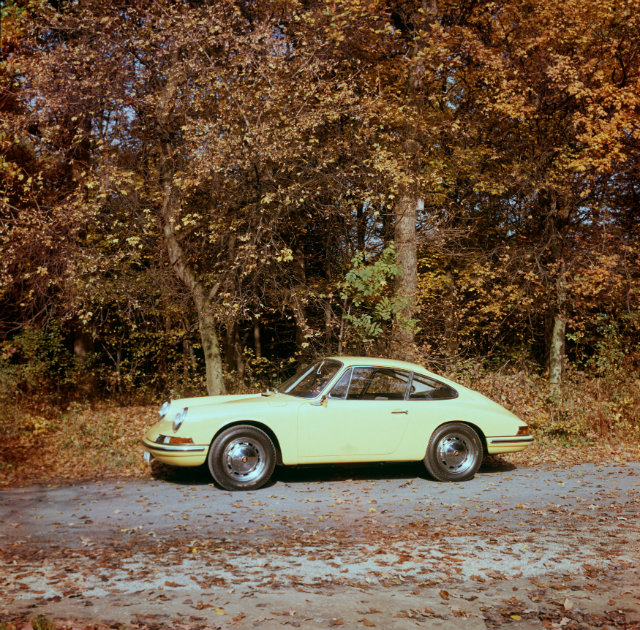
2013 Porsche 911 Carrera 4S: $145,305 ($105, 630 Base Price; Guards Red; Black/Platinum Gray Leather Interior, $4120; 3.8-liter horizontally opposed, double overhead cam 6-cylinder with Direct Fuel-Injection, 4 valves per cylinder and integrated dry sump lubrication with 400HP and 325 lbs-ft of torque; 7-speed Porsche Doppelkupplung (PDK) transmission, $4080; all-wheel drive; 13.4" disc brakes with vented rotors with 6 piston calipers, front; 13" disc brakes with vented rotors with 4 piston calipers, rear; 8.5x20" alloy wheels with 245/35ZR20 tires, front; 11x20" alloy wheels with 305/30ZR20 tires, rear; Adaptive Sport Seats Plus, $3465; Premium Package Plus with 18-way seats, $2330; Burmester Audio Package, $5010; Sport Exhaust System, $2950; Porsche Dynamic Chassis Control, $3160; Rear windshield wiper, $360; Adaptive cruise control, $2490; ParkAssist, front and rear, $990; Sport Chrono Package, $2370; Sunroof in glass, $1990; Power Steering Plus, $270; Electric folding exterior mirrors, $320; SportDesign steering wheel, $490; Exclusive Options - Painted vehicle key, $335; Wheels painted black, $1635; Wheel spacers, 5mm, $490; Sport Seats plus black leather, $1870, Destination Charge, $950)

Adherence to Brand Image: This 911 is the essence of the enthusiast side of Porsche, the car for the True Believers who still covet Porsche and what the company stands for more than any other car. But there's the rub. Porsche is two companies now and the dichotomy is laid bare for all to see. The days of being purveyors of wonderfully edgy hair-trigger sports cars have long since faded into the history books. Porsche, the company, is big business now. As a matter of fact, Porsche, along with Audi, are the profit centers that drive the VW Group conglomerate. And what does Porsche sell most of these days to deliver those profits? The Cayenne SUV, followed by the Panamera sedan. So the powers that be at Porsche constantly find themselves walking a fine line, as in "how do we keep our enthusiast customer base happy while churning out more and more of the big-time profit generators like the Cayenne and the Panamera?" As I've said previously, at some point the people who only know Porsche for sedans and SUVs will outnumber the enthusiasts who remember what Porsche stood for way back when. And at that point Porsche will be in deep trouble. But in fairness to Porsche leaders, they believe that as long as they keep accelerating profits from SUVs and sedans, it will allow them to fund the development of designing, engineering and building wonderful sporting machines like the 918, 911, Boxster, Cayman and the endless variants of those cars that seem to come like clockwork. In the meantime and in an effort to calm the faithful, Porsche feels that its burgeoning Le Mans racing program, which will debut next year, will firmly refocus the brand and fuel the enthusiast True Believers who have long supported it. I agree, at least up to a point. But what are the two most important vehicle launches of the next year for Porsche? The freshened Panamera, and the all-new Macan, a smaller crossover/SUV that will slot below the Cayenne. Uh, yeah, there's that. As far as adherence to brand image, the 911 Carrera 4S that we had the pleasure of driving basically has a foot in both Porsche camps. On the one hand, as a go-fast machine it is positively intoxicating and it adheres to the Porsche mission convincingly. It's all 911 through and through, at least what defines the new 911. But on the other hand, one look at its usurious option list and you can see how the "other" Porsche - the one that makes money hand over fist for the VW Group - currently holds sway. And so it goes. - PMD



 (VW Group)
(VW Group)
It is has been 60 years since the prototype of the Volkswagen Karmann Ghia was shown internally, on the occasion of the Paris Motor Show, and it went into full production in 1955. Positioned above the Beetle, the Karmann Ghia broadened VW's customer base considerably. Today the one-off prototype is one of the stars of the Volkswagen Osnabrück Automobile Collection. The genesis of the car came from Wilhelm Karmann, who hired Luigi Segre of Carrozzeria Ghia in Turin to transform his idea into reality in early 1953, without even consulting Volkswagen. Initially, a convertible sports car was envisioned, but the prototype was actually a coupe. Volkswagen Beetle running gear underpinned all 450,000 Karmann Ghias, known internally as the type 14, made between 1955 and 1974. Wilhelm Karmann’s idea of a convertible version - once again designed by Luigi Segre and his team - went into full production in 1957. By the time Karmann Ghia production ended in 1974, 362,601 coupes and 80,881 cabriolets had rolled off the line. The one-off coupe prototype is part of the Volkswagen Osnabrück private collection, but can be seen outside the factory on special occasions such as the 5th Schloss Bensberg Classics (from September 6-8). The Karmann factory is now part of the VW Group as Volkswagen Osnabrück GmbH and produces the Golf Cabriolet, the Porsche Boxster and Cayman, and the Volkswagen XL1.
 (VW Group)
(VW Group)
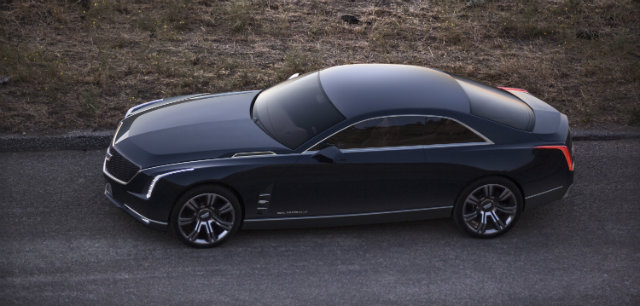 (Courtesy of General Motors)
(Courtesy of General Motors)
Cadillac revealed the Elmiraj Concept at Pebble Beach, calling it a modern update to the classic format of a two-door grand coupe. Elmiraj is "a pure expression of streamlined design and engaging rear-wheel drive performance," according to Cadillac PR minions. The concept "advances Cadillac’s philosophy of dramatic design and performance, and its commitment to lightweight, agile cars." Elmiraj is constructed with chassis and structural elements of an ongoing Cadillac rear-wheel-drive vehicle development project slated for future production (aka the vehicle coming that will be bigger than the XTS, but not as big-time as the Ciel). Elmiraj is powered by a 4.5-liter twin turbocharged V8 delivering an estimated 500 hp. The engine takes the baseline technology from the new Cadillac Twin Turbo V6 featured in the upcoming 420-hp 2014 CTS Vsport (dumb name, by the way) edition, and expands it to the classic performance format of a V8 engine. The face of Elmiraj experiments with new visual elements, yet is unmistakably Cadillac. The interior of Elmiraj includes backlit titanium trim from the cowl to the doors, dividing the upper camel leather from the wood trim. Cadillac Studio craftsmen handpicked fallen Brazilian Rosewood, a wood veneer prized for its use for hundreds of years in home furnishings and musical instruments. The wood is hand-cut into three dimensional sections for perfect control of the grain flow. The car’s instrumentation features an analog tachometer and speedometer that are transparent. Directly behind the analog gauges sits a wide screen, high resolution display, which projects driver information and the output of a front-mounted camera. The 2+2 layout features high-performance seats, designed to support spirited driving while also delivering luxury accommodation. “We were influenced in particular by the 1967 Eldorado, both its actual design and the fact that in its time that car was a very stark contrast and a new direction. More recent design like the CTS-V Coupe and the ELR are provocative,” said Clay Dean, executive director of advanced design. “Both of these cars were major statements of performance and luxury and drove Cadillac forward into new territory.” Designers at General Motors’ advanced design studio in North Hollywood, Calif., under the direction of Frank Saucedo, led the development of the car’s interior and exterior. Elmiraj was hand-built by in-house craftsmen in Michigan. See more coverage and Peter's comments from Monterey/Pebble Beach in this week's Rant.
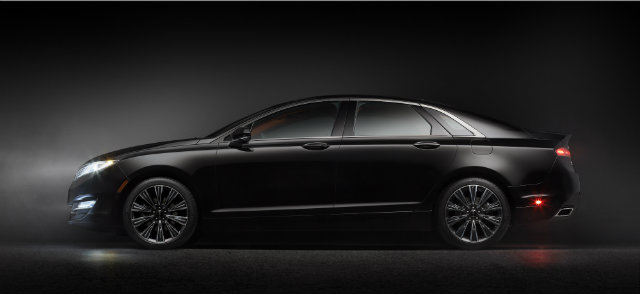 Lincoln Black Label Center Stage.
Lincoln Black Label Center Stage.
(All photos courtesy of The Lincoln Motor Company)
Lincoln previewed Lincoln Black Label today at Pebble Beach. Presented as a new and higher level expression of Lincoln design, style, materials, craftsmanship and personal service and experience, Lincoln Black Label is a collection of ultra-premium exterior and interior themes mated to an even higher level of personal services and experiences that mark the next step in the brand’s reinvention. Limited-edition design themes, ultra-premium materials, meticulous execution and elevated client service will be the hallmarks of Lincoln Black Label. The three design themes are Center Stage, Indulgence and Modern Heritage. Showcased on an all-new MKZ and the MKC Concept, Lincoln Black Label eventually will be available on every new Lincoln vehicle. “Lincoln Black Label will offer an experience for our clients that will engage them, not overwhelm them,” Jim Farley, executive vice president of Global Marketing, Sales and Service and Lincoln. “Lincoln Black Label is another important step in our brand’s reinvention to appeal to a whole new group of progressive luxury clients.” Lincoln Black Label is intended to launch near the end of 2014.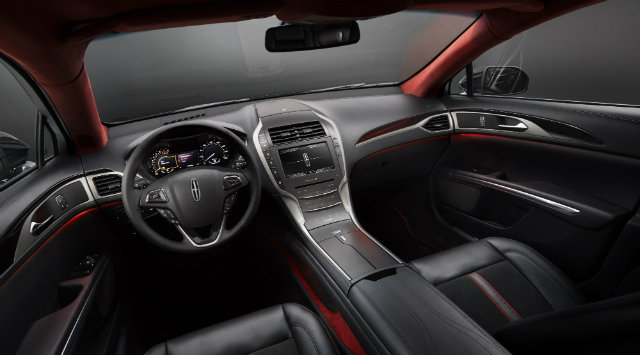 Lincoln Black Label Center Stage, inspired by fashion and theater, is designed for the most expressive clients. The Jet Black interior is highlighted by a Foxfire Red headliner, capturing the drama of being in a dark theater with the impact of a rich, deep red accent color. Alcantara suede with uniquely designed perforation adds plush texture to the doors and seats.
Lincoln Black Label Center Stage, inspired by fashion and theater, is designed for the most expressive clients. The Jet Black interior is highlighted by a Foxfire Red headliner, capturing the drama of being in a dark theater with the impact of a rich, deep red accent color. Alcantara suede with uniquely designed perforation adds plush texture to the doors and seats.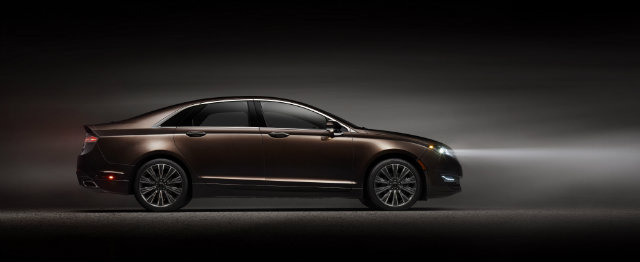 Lincoln Black Label Indulgence.
Lincoln Black Label Indulgence.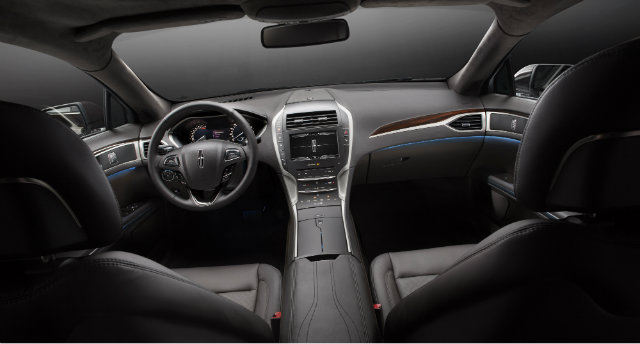 Lincoln Black Label Indulgence is inspired by the lure of premium chocolate to ignite a rich sensory experience. Ganache- and Truffle-colored Venetian leather with a subtle antiqued finish adds richness and depth. The Ziricote wood trim features a beautiful natural grain and color inherent in the wood with no added dyes or stains. This wood - new to the automotive industry - is often used in high-end yachts.
Lincoln Black Label Indulgence is inspired by the lure of premium chocolate to ignite a rich sensory experience. Ganache- and Truffle-colored Venetian leather with a subtle antiqued finish adds richness and depth. The Ziricote wood trim features a beautiful natural grain and color inherent in the wood with no added dyes or stains. This wood - new to the automotive industry - is often used in high-end yachts.
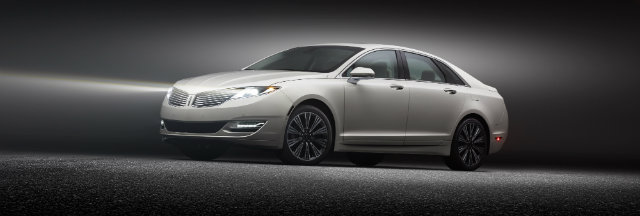 Lincoln Black Label Modern Heritage.
Lincoln Black Label Modern Heritage.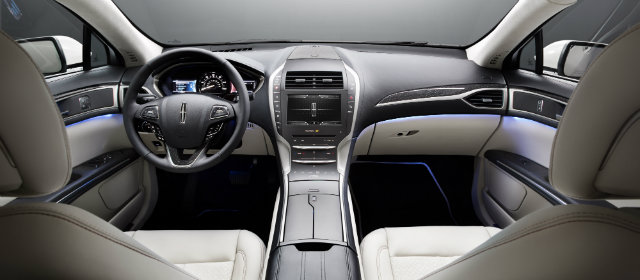 Lincoln Black Label Modern Heritage offers a fresh take on the classic black-and-white interior with subtle red accents. Designed for the client who appreciates a clean, modern aesthetic, the soft white interior is warm and inviting. Renewed and engineered wood trim - imbued with metal flake between its layers - creates a sparkling effect to stylishly highlight this modern classic design.
Lincoln Black Label Modern Heritage offers a fresh take on the classic black-and-white interior with subtle red accents. Designed for the client who appreciates a clean, modern aesthetic, the soft white interior is warm and inviting. Renewed and engineered wood trim - imbued with metal flake between its layers - creates a sparkling effect to stylishly highlight this modern classic design.
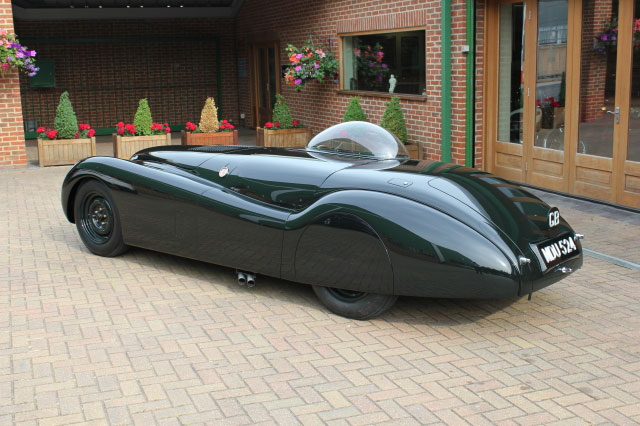 (Jaguar)
(Jaguar)
The restored Jaguar XK120 that broke the land speed record of 172+ mph in 1953 won “Best in Class, Post War Racing” this week at the Quail Motorsports Gathering, part of the Pebble Beach festivities on the Monterey Peninsula. Legendary driver Norman Dewis, who set the production car world land speed record driving this same XK 120 at Belgium’s Jabbeke Motorway in 1953, was in attendance. This was the first time Dewis has seen the “Jabbeke Jag” since he drove it that historic day 60 years ago.
 (Ford)
(Ford)
Meet Floyd Pullin of Confluence, Pennsylvania. Quite possibly Ford’s most loyal customer, the sprightly 102-year-old has been an exclusive Ford owner since the 1920s – back when Henry Ford was still running the company. Floyd recently took delivery of his 16th Ford, a brand new 2013 F-150 STX. To thank him for his loyalty and help celebrate a birthday he won’t forget, Ford has named him Honorary Ford Trucks President for a day. Thurby Riverside Ford owner Joey Thurby (above, left) presented Floyd with his honorary title.






